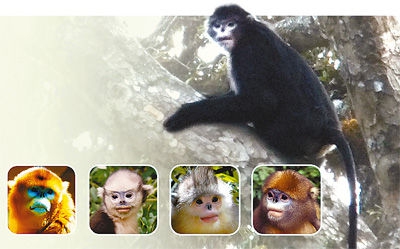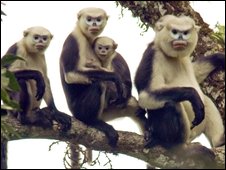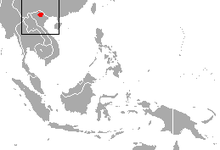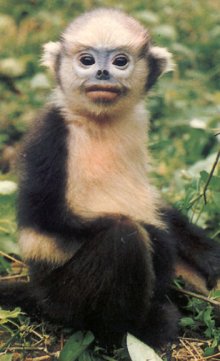Two Different New Snub-Nosed Monkey Discoveries
Posted by: Loren Coleman on May 22nd, 2012

Earlier in May 2012, scientists at the Kunming Institute of Zoology announced they have discovered the world’s fifth species of snub-nosed monkey in China’s Nu River Valley. More widely known as the Myanmar Snub-nosed Monkey since it was first discovered in northeast Burma, this rare species has been dubbed the “Nu River snub-nosed monkey” in Chinese by scientists, who confirmed their relation to the Burmese species through a DNA analysis of their excrement collected near the Nu River in Yunnan province in March 2012. Forest guards in the Gaoligong Mountains nature preserve were also able to take pictures of a group of 60 to 80.

The species was first discovered by the Fauna & Flora International in early 2010 and was given the Latin name Rhinopithecus strykeri on October 27, 2010 (above). Among its defining characteristics are its black fur, white face and chest, and a propensity to sneeze when it rains. It is the world’s fifth subspecies of the snub-nosed monkey. China is now home to four species of snub-nosed monkeys: the Sichuan golden hair monkey (or Golden snub-nosed monkey), the Black (or Yunnan) snub-nosed monkey, the Gray (or Guizhou) snub-nosed monkey, and now the Myanmar (or Nujiang) snub-nosed monkey. The fifth species, the Tonkin snub-nosed monkey, is endemic to northwest Vietnam.

Meanwhile, new May 2012 sightings of the elusive Tonkin snub-nosed monkey (above) are rare. It’s no wonder a recent sighting of a group in Vietnam has proved cause for celebration.
Believed to be fewer than 200 of the species remaining, this positive sighting by Fauna & Flora International’s community patrol group in Khau Ca forest, identified a group of 80 monkeys, including 16 infants.

Such large gatherings of leaf-eating primates are known to occur seasonally, but with the number of the species dwindling rapidly, groups of this size are rarely observed.
Tonkin snub-nosed monkeys are amongst the rarest primates in the world, found only in Vietnam. Despite strict legal protection under local laws, the species is heavily hunted and most of the remaining subpopulations are so small that their survival cannot be guaranteed.

The population at the Tonkin Snub-nosed Monkey Species and Habitat Conservation Area at Khau Ca, where this group was seen, is the largest remaining and is currently estimated to comprise a total of about 110 individuals.

To breed successfully Tonkin snub-nosed monkeys need good quality forest and absolute safety from hunting. Fauna & Flora International has been supporting the local forest protection authorities in Khau Ca for a decade, to safeguard these impressive primates. The University of Colorado at Boulder and the Zoos of Denver, San Diego and Singapore also contribute to conservation at this site and the joint efforts appear to have led to a stabilisation and gradual recovery of the Tonkin snub-nosed monkey population at Khau Ca.
About Loren Coleman
Loren Coleman is one of the world’s leading cryptozoologists, some say “the” leading living cryptozoologist. Certainly, he is acknowledged as the current living American researcher and writer who has most popularized cryptozoology in the late 20th and early 21st centuries.
Starting his fieldwork and investigations in 1960, after traveling and trekking extensively in pursuit of cryptozoological mysteries, Coleman began writing to share his experiences in 1969. An honorary member of Ivan T. Sanderson’s Society for the Investigation of the Unexplained in the 1970s, Coleman has been bestowed with similar honorary memberships of the North Idaho College Cryptozoology Club in 1983, and in subsequent years, that of the British Columbia Scientific Cryptozoology Club, CryptoSafari International, and other international organizations. He was also a Life Member and Benefactor of the International Society of Cryptozoology (now-defunct).
Loren Coleman’s daily blog, as a member of the Cryptomundo Team, served as an ongoing avenue of communication for the ever-growing body of cryptozoo news from 2005 through 2013. He returned as an infrequent contributor beginning Halloween week of 2015.
Coleman is the founder in 2003, and current director of the International Cryptozoology Museum in Portland, Maine.










(sings) Monkey magic, monkey magic!
They are wonderfuly creepy monkeys!
Some of these snub nosed monkeys are cute, but the Rhinopithecus strykeri (the bald-looking white one) looks like a freaky evil clown.
Becha wawa! 😛
‘Wicket the Ewok’